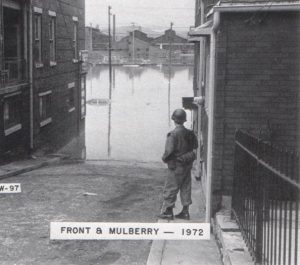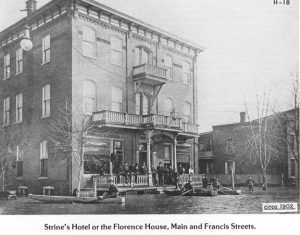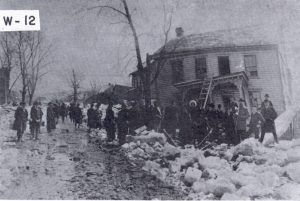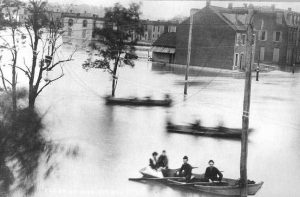
The West Side during the ’36 Flood. Photograph from the John Yetter Collection, with permission from the Penn Cultural Center
The Susquehanna River has overflowed its banks longer than the town of Steelton has existed. This natural process has been a part of the history of the Susquehanna. The first recorded flood came in 1744, more than a century before the town of Baldwin (later renamed Steelton) was formed. Once people moved into this area, they had to cope with the irregularity of floods. During most flood years, the water level did not rise high enough in the town to create much economic or human loss. Many of the floods in the recorded history of Steelton have only affected the West Side, due to its location near the river and its topographic level. Every once in a while, however, there came a flood that caused so much devastation that it was remembered vividly by those who had to endure it. Nonetheless, as some of the “old timers” will tell you, each flood has been unique. In some years, they had time to gather their possessions and tools in the mill and bring them to higher, safer elevations. During other times, the flood came as a surprise. No matter how and when the floods came, the residents seemed to have always helped one another to survive and rebuild. John Yetter described it best in his book Stop, Look, Listen: Steelton, Pennsylvania “It seemed to prove beyond a doubt that people are much more compatible in adversity than they are in prosperity.”
Below is information about some of the major floods in the area.
1889 (June) – Known simply as “The ’89 Flood,” it is remembered as creating some of the worst damage in history. The whole West Side and steel plant were under about ten feet of water. Many of the residents whose homes were under water were able to find shelter and food provided by other neighbors and churches in Steelton. The flood hit worst in Johnstown, another small steel town in Pennsylvania, taking more than 2,000 human lives. This picture shows some of the aftermath of the flood in the West Side. The logs floated from Williamsport, PA.
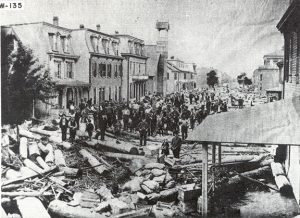
The Aftermath of the ’89 Flood’ in the West Side. Photograph from Stop, Look, Listen: Steelton, Pennsylvania
1894 (May) – The water level rose to 13 feet, causing great damage in Steelton.
1902 and 1904 – After two floods within a few years, many of the residents concluded that the railroad tracks next to the river were too low. They believed if the tracks were higher, than there would be fewer floods. It appeared that the tracks slowed the frequency of the floods, because the next floods were separated by about thirty years. The picture on the left shows Strine’s Hotel during one of the floods. The right picture shows some of the damage and debris from the floods. Both photographs are from Stop, Look, Listen: Steelton, Pennsylvania.
- Strine’s Hotel circa 1902
- The West Side during a flood.
1936 (March) – This flood caused one of the highest water levels ever in Steelton, with a recorded 30.33 feet on March 19th. Since it occurred during the Great Depression of the 1930’s, many organizations, including the government, could not help the businesses and residents with economic recovery. Some businesses, like the one at Front St. and Locust St. in the picture below, tried to cope with the water by building simple docks and ramps so customers could continue to enter.
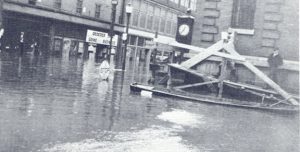
Intersection of Front and Locust Streets during the 1936 Flood. Photograph from Stop, Look, Listen: Steelton, Pennsylvania
1972 (June) – The “Agnes Storm” rained down on Steelton continuously for more than two days, amounting to 32.7 feet of water on June 24. This caused some major damage to the town, especially on the West Side. Shortly after, the federal government decided it would be best to tear down the West Side of Steelton and removed most of the houses and buildings. In other parts of the town, some long-time businesses decided to use this flood as an excuse to close. About 5,000 steelworkers could not go to work for awhile because many parts of the mill were damaged by the waters.
Keith Travenstein, a Steelton resident, describes the moment the water level rose:
“It just came to our basement and as little kids coming around the corner, we were stopped by the National Guard unit…As soon as we ran around the corner, the water was up, almost to 2nd Street.”
Mitch Ivanoff, a steel worker and union member, described how the flood changed life in Steelton:
“Each area had its own churches, it had its own schools, after the flood, you know, everybody went, they moved out. They moved to Chamber Hill, Chambersville, and Rutherford, Colonial Park, across the river, out of Steelton. Back in the old days, we’d get off work and the whole turn would stop at a bar. You’d have forty, fifty guys working in a department and they’d all go out together, they’d flood a place. Now, after work, you don’t want to stand in front of anybody in the parking lot because they’re out doing their own thing. That camaraderie, that community that used to exist in the mill was incredible, particularly when we worked around the clock.”
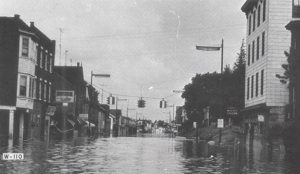
Front Street during the 1972 Flood. Photograph from Stop, Look, Listen: Steelton, Pennsylvania
1975 – Even though it was not nearly as detrimental, the flood ruined some of the new rebuilding plans that were taking place as a result of the flood in 1972. It has been the latest flood to date in Steelton.
One of the most unfortunate aspects of a flood like those that hit Steelton is the collection of oil, gasoline, and other hazardous materials in the water that are picked up from gas stations and street surfaces. Rising water levels collected high amounts of these materials and distributed them throughout houses, businesses, automobiles, and yards. Since oil, gas, and other pollutants were distributed across the town, they inevitably got into the food and water sources, then which eventually entered humans, animals, and plant life. After a flood, one can often see an oily residue on many of the structures.
No matter what the water level was or how much damage was caused, the people of Steelton grew closer together during the flood seasons. As a result, they were able to withstand not only the floods, but many of the other disasters that have come and gone throughout Steelton’s existence.
